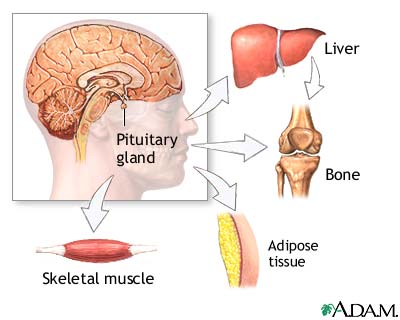
Overview
The growth hormone (GH) is a protein hormone released from the anterior pituitary gland under the control of the hypothalamus. In children, GH has growth-promoting effects on the body. It stimulates the secretion of somatomedins from the liver, which are a family of insulin-like growth factor (IGF) hormones. These, along with GH and thyroid hormone, stimulate linear skeletal growth in children.
In adults, GH stimulates protein synthesis in muscle and the release of fatty acids from adipose tissue (anabolic effects). It inhibits uptake of glucose by muscle while stimulating uptake of amino acids. The amino acids are used in the synthesis of proteins, and the muscle shifts to using fatty acids as a source of energy. GH secretion occurs in a pulsatile (short, concentrated secretion) and sporadic manner. Thus, a single test of the GH level is usually not performed.
Review Date 1/9/2022
Updated by: Robert Hurd, MD, Professor of Endocrinology and Health Care Ethics, Xavier University, Cincinnati, OH. Review provided by VeriMed Healthcare Network. Also reviewed by David Zieve, MD, MHA, Medical Director, Brenda Conaway, Editorial Director, and the A.D.A.M. Editorial team.


